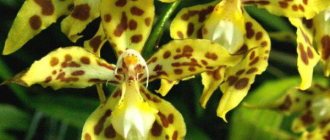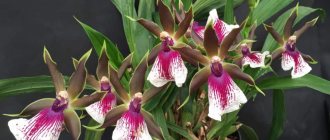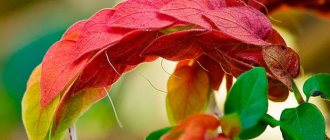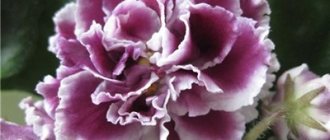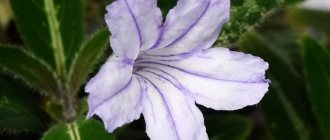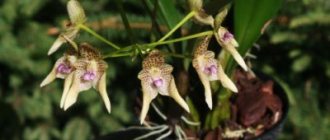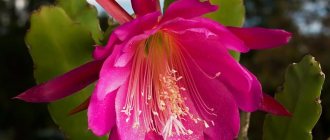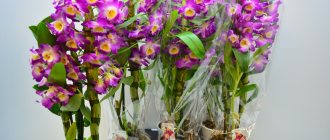Orchids. Magnificent, exquisite, shrouded in mystery, plants have captivated the human imagination for many millennia.
Mention of them can be found already five centuries before the new era by the Chinese philosopher Confucius, who compared the contemplation of orchids with meeting a good friend. The Aztecs worshiped the wondrous plant, considering it a miracle of nature. Europeans began cultivating these tropical flowers in 1698, when the first specimen was brought to Holland.
But
the finicky nature of delicate beauties causes difficulties when growing indoors . It is best to start creating a home collection of orchids with Ludisia, which is characterized by its unpretentiousness to growing conditions.
Precious orchid Ludisia: description of the variety and care at home
Description
Genus Ludisia is an evergreen representative of the Orchid family. Includes one species - Ludisia bicolor, represented by several varieties based on leaf color.
The plant is classified as “precious” because of the beauty of its leaves , because it does not differ in the splendor of flowering.
A small orchid has fleshy, strong stems that spread over considerable distances in diameter and produce multiple vertical shoots.
The stems are soft and fleecy . The plant is attached to the ground or vertical supports using a short rhizome with numerous branches.
IMPORTANT! Ludisia was introduced into indoor culture by the Russian breeder F.A. Bersenev. The uniqueness of the tropical guest lies in its relatively simple cultivation, although it is an exotic flower.
The beauty of Ludisia is provided by its leaves . On the stem they are located in small rosettes of 5 leaves. The leaves are lanceolate or oval-shaped, alternate, on a flat petiole. The length of the leaves is up to 7 cm.
Various colors: dark green, olive, red, brown or black . The upper side of the leaf shimmers in sunlight due to a velvety patterned coating, and the lower surface is smooth, brown or burgundy.
The life cycle of the Ludisia leaf is 7 years . And throughout this period the leaf does not lose its decorativeness and vitality. After the leaves die, a ring scar remains on the stem.
The orchid blooms for about 5 weeks . The plant produces a straight peduncle up to 30 cm high from each rosette of leaves. It blooms with small white flowers with a corolla of yellowish stamens; on each peduncle - up to 30 flowers. When flowering, the orchid emits a delicate aroma and looks like a pearl necklace.
Photo by Ludisia.
Distinctive features
- It has small, inconspicuous flowers and magnificent leaves of various shapes and colors.;
- Able to tolerate fairly dry growing conditions and does not require much sunlight;
- Suitable for breeding by beginners and experienced gardeners;
- Usually blooms in autumn and winter;
- One of the few orchids that lead a terrestrial lifestyle. Grows on moss, rarely attached to walls;
- Does not tolerate bright sunlight and hot air;
- Requires fresh air, but is afraid of drafts;
- Air humidity should be more than 70%.
Distribution in nature
Ludisia's habitat is the moisture-soaked forest floor of the Earth's tropical zone.
The orchid is different in that it likes to settle on the ground under trees or in caves on mossy walls . In the twilight of crevices, under the canopy of crowns, the plant prefers to hide from direct rays.
The geographical area of distribution of the species is quite large. Varieties of orchids are found in many tropical countries : in Malaysia, on the island of New Zealand, in Thailand, New Guinea, and Sumatra.
The Japanese islands, the Indian Peninsula and China have chosen orchids that are tolerant of cooler climates. Deciduous representatives of this species can be found in Brazil and Vietnam. The simplest forms grow in the south of Russia.
Common colors
The colors of Ludisia are determined by the color of the leaves, since all varieties of orchids have white or slightly yellowish flowers. The most popular colors are:
- pink veins on a black and green background;
- bronze surface with copper pattern;
- bright green plate with a lighter pattern of lines;
- dark green leaf with silver coating;
- black with red stripes.
The color of Ludisia is determined by the leaves.
Goodyer
This is a very rare plant. The genus Goodyear (or goodyear) includes plants of quite large size in comparison with other members of the family (up to 18 cm). They have fleshier, very beautiful leaves that can be colored in various shades of green.
The rosettes are large and last for several years. The veins of these beauties do not have a metallic sheen. They can be white or pink, less often bluish. Goodyer bristles (hispida) is the most famous. Goodera creeping, reticulated and fluffy are much less common.
Reviews
Tatyana Anatolyevna. “We gave Ludisia Alba as a birthday present. It has been growing at home for 8 months. I tried to bloom in November. On the advice of experienced flower growers, I had to remove the peduncle - it was a great pity. But the plant is still young and could die. The orchid is on a western windowsill, there are no problems with lighting. To maintain humidity, I keep a humidifier next to it. The orchid is doing well - the leaves are powerful, bright green with beautiful white veins. A wonderful gift! I am very pleased!"
Alevtina Viktorovna. “I have been growing Ludisia for almost three years. We bought it by chance at a flower market. I really liked the leaves: almost black with a silver velvet pattern. Later I learned that these orchids are called precious because of the beauty of their leaves. At first I was worried that I wouldn’t be able to care for her properly. But my jewel turned out to be picky and makes me happy what a year. It bloomed twice with small flowers with a delicate aroma. I advise everyone to grow such beauty!”
Leoncia. “I want to share my joy: after three years, my Ludisia orchid bloomed! What have I done all these years to persuade her to bloom. As a result, I learned that an orchid blooms in its third year of life. But now an exquisite aroma spreads throughout the apartment. Flowers are like little pearls. Those who consider the flowering of Ludisia to be ordinary are wrong! It's just exquisite beauty! I'm happy!"
Adaptation of orchids to habitats
The overwhelming number of orchid species are confined to the tropics and subtropics, but in our central Russia, more than 150 species of orchids live in meadows, forest glades, along roadsides, in the mountains and even beyond the Arctic Circle.
Epiphytic species adapted especially well to strong solar radiation and prolonged droughts; their shoots and leaves even turned into reservoirs for storing water, and photosynthesis became almost the same as that of cacti and succulents.
As a result, many orchid species have become so adapted to their pollinators that often only an insect of one species (or even gender) can transfer pollen from one flower to another. But on the other hand, orchid flowers are ideally adapted to this single pollinator.
Need to discourage pollinators from other plants?
European Ophrys will bloom in the spring much earlier than other plants; the smell and appearance of the flowers, reminiscent of female wasps, will attract the attention of male wasps. Males ready to mate will mistake orchid flowers for females and try to mate with them
Do bees and bumblebees see well in ultraviolet light?
Many tropical orchids have a pattern on the lip (the special petal of a flower that serves as a landing site for pollinators) that is clearly visible under ultraviolet light and forms a path leading to the pollinia.
Do night moths navigate by smell and, sucking nectar on the fly, never land on a flower?
The flowers of such orchids are almost always white or greenish in color, they have a strong aroma and a nectar-filled spur, and their parts are bent back so as not to interfere with the free flapping of the wings of the pollinating butterfly.
In addition, epiphytic tropical orchids depend on animal pollinators (birds or bats) and host trees to live and thrive. It is also closely related to fungi, thanks to the symbiosis with which orchids have invented their own unique method of germination.
The seeds consist of an embryo and a thin seed coat. Penetrating into the embryo, the fungus supplies it with all the substances necessary for germination, since the seeds themselves do not have cotyledons, and, therefore, no nutritional substance. In one seed capsule you can count from several thousand to 2-3 million seeds.
Just as out of millions of fish eggs, only a few dozen survive, from each orchid seed capsule in nature, usually no more than 0.001% of the seeds germinate. But despite this, orchids in the tropics thrive due to their plasticity, ability to survive adverse conditions and quickly adapt to environmental changes.
External characteristics
The height of an adult plant in its natural habitat is usually 15-20 cm; at home, an orchid does not grow more than 15 cm. But it occupies a significant area due to its numerous branches.
Ludisia is considered a medium-sized but fast-growing crop.
The leaves are the main distinguishing feature of Ludisia, a factor why gardeners love to cultivate this orchid. On each stem of adult specimens there are up to 5 dense, variegated leaves that sparkle in the sun.
In late autumn or winter, erect peduncles 25-30 cm long appear from the center of the upper leaf rosette, on which a raceme with many buds develops. This is how the plant prepares for flowering, which can last for quite a long time, but does not attract the admiration of gardeners.
Ludisia's flowers are small, no more than 2 cm in diameter . The shape is a little reminiscent of Lamiaceae flowers: a long peduncle, the upper petals are round in shape, the lower petals are elongated, slightly beveled to the side. Long yellow stamens crown the white flower, exuding an exquisite aroma. A blooming orchid cluster resembles a bunch of pearls.
Makodes
These are terrestrial orchids with creeping shoots that reach 7-8 cm in height, while they are densely branched. One of the most common species is the macodes petola orchid - a variegated plant with oval, perfectly regular leaves with a slightly pointed edge and beautiful velvety pubescence. Their length is 7.5 cm.
The light green, dark green, grayish or emerald base of the leaf blade is intersected by veins, among which a thin web of various patterns is clearly visible. A special combination of color shades creates the feeling that the leaves of the makodes are decorated with golden lace. This orchid produces up to twenty white-brown flowers, which are located on tall peduncles.
After flowering ends, the rosette dies and lateral shoots form. In contrast to this species, the more spectacular and larger species of makodes Sandera grows up to 15 cm. It is distinguished by a copper veining effect.
Main features of flowering
Orchids are representatives of tropical flora and love hot and humid climates. Therefore, flowering in most species occurs in the spring-summer period , the most favorable for seed ripening.
ATTENTION! Ludisia blooms in autumn and winter; this is the best option for it, since it is demanding of excess sunlight and heat.
When optimal conditions are created, Ludisia can bloom for up to 5 weeks . To do this, the plant should not be kept near heating devices or in direct sunlight. An open window requires shading . When the plant is located far from the window, lighting is needed, but no more than 12 hours a day.
Ludisia can bloom for up to 5 weeks.
Repeated flowering is observed mainly in phalaenopsis, but sometimes other orchids repeat flowering - completely unexpectedly. In Ludisia, the peduncle dries out completely, possibly with one or two leaves. But the rows are formed of children who will then give flowers.
Stimulation of flowering of Ludisia must begin in the summer. When the plant is 3 years old and this process will no longer harm it, in order to set buds, the daytime temperature in summer must be maintained in the range from 20 to 29 degrees. Night temperatures are reduced by 3-5 degrees. In autumn, the main thing is to monitor the conditions so that the plant does not go into hibernation. When flowers appear, the thermometer should not rise above 18 degrees to extend the flowering period.
Temperature
Precious orchids are perfectly suited to normal room temperature. They do not tolerate sudden cold spells; it is undesirable for the temperature to drop below +18 °C. This can lead to loss of decorative leaves and early flowering. But variegated orchids are not afraid of heat and recover well even with sudden temperature increases above the minimum level.
It is worth noting the special requirements of some species: for example, Ludisia prefers that the night temperature be 4-5 degrees lower than the daytime temperature, however, many other representatives of the species develop better in exactly this temperature regime. After flowering, only anectochilus requires a period of rest: at this time the temperature should be at least slightly (2-4 degrees) lowered.
Rules for growing at home
Ludisia is a shade-loving flower , so it is better to keep it on those windows where little sunlight reaches. It is possible to grow far from the window - but with twelve-hour illumination.
Temperatures in summer are 20-29 degrees during the day and 17-24 degrees at night. Water with settled water, preferably in a tray; Drain off excess moisture, but do not let the soil become dry.
In winter, Ludisia should be protected from drafts. Do not over-moisten. You cannot spray the leaves in the usual way - the leaves will be damaged by water and spots will appear.
You can place a vessel with water next to the flower. Peduncles have appeared - we lower the degrees to 18 units.
The plant needs to be fed only when flowering - twice a month . Subject to regular transplants, Ludisia will receive all useful substances from the soil. Watering must be regular as the soil dries out.
Important! When a peduncle forms, water should not get into the leaf rosette.
Flowering can be stimulated by slight temperature changes during the day and by drying the soil at the end of autumn. Such stress will accelerate the formation of flower stalks if flower buds were laid correctly in the summer.
After the orchid has bloomed, you need to wait for the peduncle to acquire a straw color - which means it is completely dry. Can be trimmed. To do this, take a disinfected pruner. Scissors or a knife are undesirable; they can leave burrs that can become infected. Trim above a dormant bud or at the base, which is preferable for resting the plant. Disinfect the cut with charcoal. Afterwards, do not disturb the flower.
After flowering, the dried peduncle is cut off.
To prevent diseases, it is necessary to observe the correct conditions of detention. Direct rays of the sun can burn the leaves - shading will save. Excessive moisture causes the root system to rot; moderate watering and replanting to eliminate rot will help the flower. Pests on succulent leaves require insecticide treatment.
How to make Ludisia bloom
Proper care of ludisia is not always enough for full flowering. The formation of buds can be stimulated by a forced change in daily temperatures for 1 month. To do this, you need to place the pot in a room with cool air at night.
The temperature should be within 16...18 °C, subject to daily increases to 23 °C. In winter, such conditions can be created even on the windowsill, leaving the flower on it at night, and moving it deeper into the room during the day.
In cold weather, plastic glass emits fairly cool air, which will be enough to lower the temperature.
Following natural rhythms, it is better to push the orchid to bloom at the end of autumn, which will give a greater chance of success. In this case, the pot can be taken out to the balcony at night or put into an insulated cellar (garage).
Carefully! Do not forget to reduce the frequency of watering when the temperature drops, otherwise the orchid will begin to rot instead of blooming.
Landing
For planting, you should take already prepared soil . The soil should be loose, moisture-permeable, with good aeration. To prepare the soil yourself, mix particles of moss, peat mixture, crushed pine bark and charcoal in a ratio of 4:1:4:1.
Ludisia should be planted in wide, low pots . First, be sure to lay down brick chips or other drainage material. The hole in the pot should be large enough so that moisture does not linger for a long time. It’s good if the pot is transparent - after all, orchid roots are capable of photosynthesis.
When planting an orchid, its roots are placed close to the surface, making sure not to bury the growth buds. Then carefully sprinkle with soil and place sphagnum moss on top to reduce moisture evaporation. If you need to plant a shoot, it is first rooted in sphagnum or water, adding charcoal for disinfection.
Roots of Ludisia when transplanted.
Ludisia can be replanted once every 3-4 years as it grows out of the pot. The procedure is best done in the spring. The entire plant is transferred to a larger vessel, or cut into pieces and planted in several flowerpots.
Ludisia, Ludisia, Ludisia, Haemaria
Ludisia discolor is the most famous and easiest to care for of all the gem orchids. Like all gemstones, it is valued for its velvety bright leaves with shimmering light veins.
It blooms in winter with white flowers on a tall peduncle.
There are many decorative forms and varieties of ludisia: Alba, Dawsoniana, the Velvet series is especially popular (options: Green Velvet, Red Velvet, Silver Velvet, Sapphire Velvet, Emerald Velvet, Jade Velvet, Jasper Velvet).
Ludisia Red velvet - “velvet” leaves with pink stripes.
Features of growing the Ludisia orchid
The easiest to care for among jewelry!
Ludisia grows well in rooms because... undemanding to air humidity, unlike most precious stones.
When growing it, it is advisable to maintain the daytime temperature 4 °C higher than the nighttime temperature.
They plant it in ordinary pots, in a substrate consisting of bark, half-decomposed leaves and peat (1: 1: 2). And no problem! It grows and blooms beautifully. By the way, it blooms very nicely.
Flowering of the precious orchid - Ludisia bicolor
Pests and diseases and their treatment
Spider mites are the main enemy of the orchid, which sucks moisture from the plant. Its presence can be determined by the presence of fine cobweb hairs on the leaves. Mites appear at elevated temperatures and very dry soil.
If a sticky liquid is found on an orchid, we can talk about the parasitism of a scale insect - an insect with a brown shell that takes away useful substances from the flower. The mealy mite settles on Ludisia in the form of a whitish lump.
ADVICE! To control pests, acaricides and insecticides are used in combination with restoration measures. During treatment, it is better to set the orchid away from other plants.
If there is an excess of bright sunlight, the flower gets burned or its leaves lose their brightness, lighten and look sick. The plant requires shade.
Lack of lighting causes the shoots to stretch out in search of a more illuminated area - long bare stems appear. Additional lighting will help prevent this.
Bright lighting and a small amount of moisture threaten the orchid withering. Therefore, it is important to observe the correct conditions for keeping Ludisia.
Top dressing
Orchid Ludisia: photo
Ludisia is a type of orchid that requires constant and abundant feeding from its owner. This procedure will need to be carried out most often and most extensively during intensive growth. The frequency of feeding at this time should be no less than once every week or two. At all other times, of course, such intensive feeding is not needed, but it is still necessary to fertilize the flower at least once a month.
Reproduction: methods and technology
When transplanting an overgrown flower, the bush is divided into parts and planted like a regular orchid, having treated the cut areas.
Cuttings are carried out in spring and summer during the active growing season. Three buds are left on the cuttings, the sections are treated with charcoal and rooted in water or moss. After the roots appear, they are planted in the ground and cared for like an adult plant.
During the growing season, the stem is pressed to the ground and the apical part is fixed for rooting. Then they are carefully cut off from the mother plant and planted in the ground.
Anectochilus, Anectochilus, Anoectochilus
Anectochilus are low orchids with creeping horizontal stems and velvety decorative leaves. The flowers are collected in an erect raceme.
The most popular:
- beautiful anectochilus (Anoectochilus formosanus),
- Roxburgh's anectochilus (Anoectochilus roxbourghii),
- striped anectochilus (Anoectochilus vittata),
- Sikkim anectochilus (Anoectochilus slkkimcnsis),
- royal anectochilus (Anoectochilus regalis).
Anectochilus Roxburgh in nature
Features of growing orchids - anectochilus
For successful maintenance, they need to be provided with a period of rest, with a slight decrease in temperature and reduced watering.
Intergeneric hybrids
Anectomaria, Anoectomaria - hybrids (Haemaria × Anoectochilus) - maintenance requirements are similar to caring for ludizia.
And further
Dossinochilus (Dossinia x Anoectochilus)
Goodisachilus (Goodyera x Ludisia x Anoectochilus);
Ludochilus (Ludisia x Anoectochilus);
Anoectodes (Macodes x Anoectochilus).
Ludochilus Poly
Description of the plant, photo
Ludisia is a monotonous orchid, which is a herbaceous evergreen crop from the Orchidaceae family. The second name of the plant is gemaria. Its fleshy creeping shoots spread along the surface of the soil and produce short vertical stems no more than 15 cm high. The broadly-lanceolate leaves are arranged in an alternate order and can be of the vaginal or vaginal-petiolate type. Their front side has a shiny velvety surface, painted in rich deep colors - from green-emerald to burgundy, brown and even almost black. Characteristic of the genus is longitudinally patterned venation, almost invisible in the original species form and brightly contrasting in varietal varieties. The underside of the leaf is smooth, monochromatic, its color matches the color of the wide cuttings (if any). Each leaf of Ludisia lives for about 7 years, after which it withers and dies, leaving behind a ring-shaped notch on the shoot, distinguished by its lighter color.


